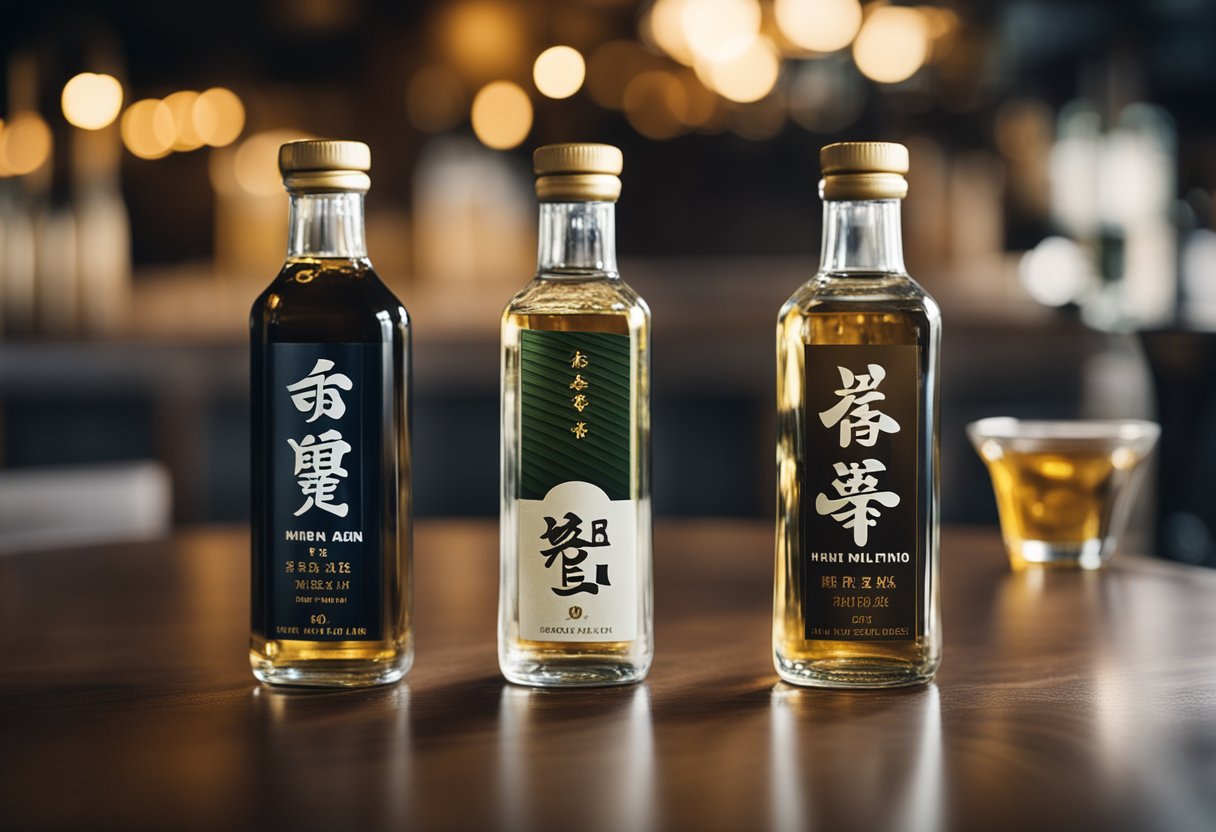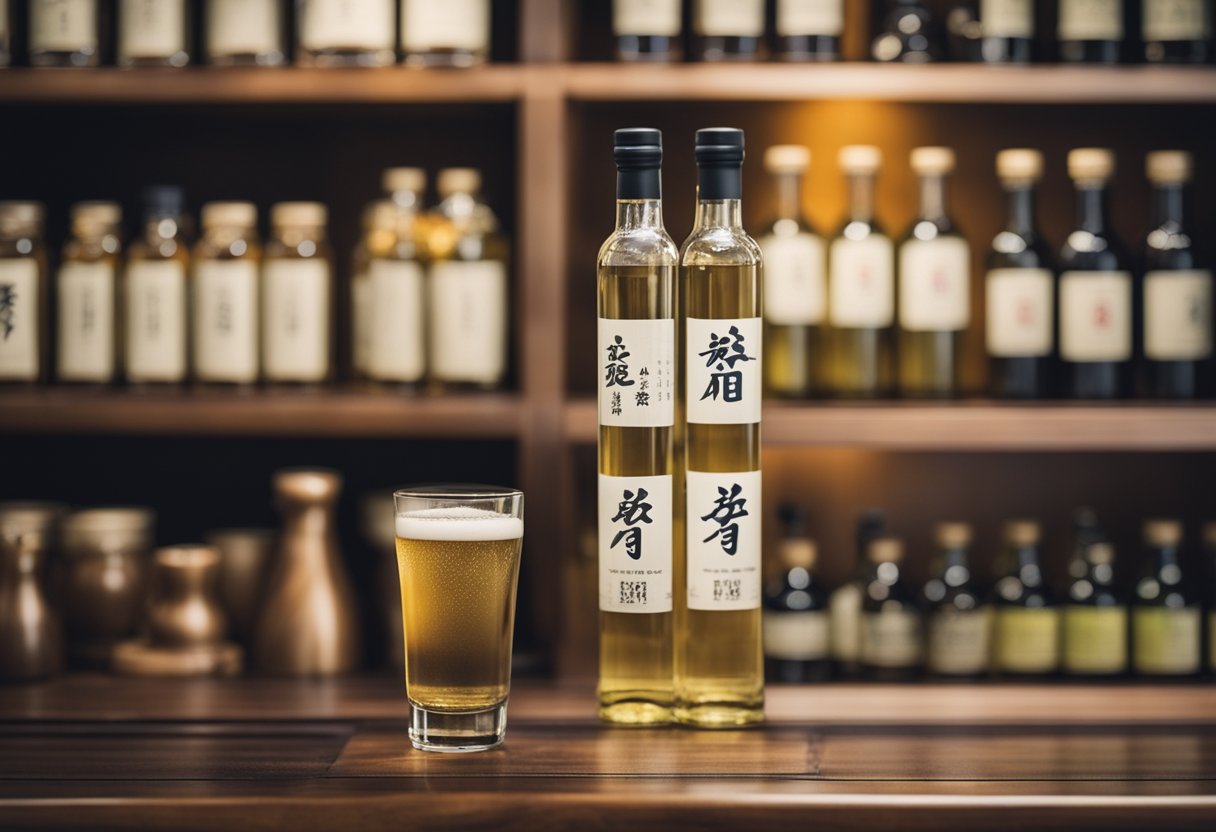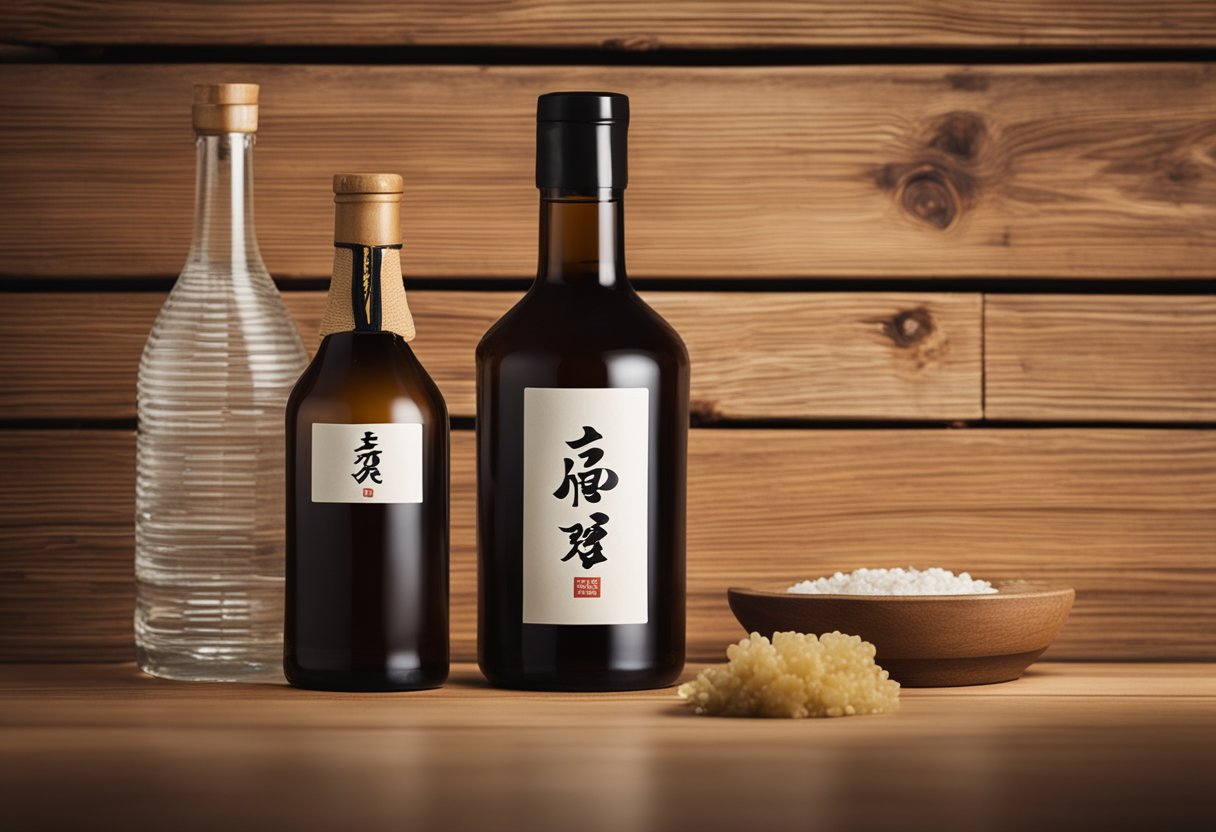As a lover of Japanese cuisine, I have often come across the terms “sake” and “mirin” in recipes and menus. These two ingredients are essential to many Japanese dishes and are often used interchangeably, but they are not the same thing.
In this article, I will explore the differences between sake and mirin, their production processes, nutritional differences, taste profiles, culinary uses, substitutes, shopping and storing tips, potential health effects, and more.

Understanding Sake and Mirin Sake and mirin are both traditional Japanese rice wines, but they differ in terms of their alcohol content, flavor, and usage. Sake is a fermented alcoholic beverage made from rice, water, and koji mold.
It has a higher alcohol content than mirin and a neutral flavor that can range from dry to sweet. Sake is often consumed as a drink, but it is also used as a cooking ingredient in marinades, sauces, and soups.
Mirin, on the other hand, is a sweet rice wine that contains less alcohol than sake. It is made by mixing steamed glutinous rice, koji mold, and shochu (distilled alcohol).
Mirin is mainly used as a seasoning and sweetener in sauces, marinades, and glazes to add a glossy finish and depth of flavor to dishes.
Key Takeaways
- Sake and mirin are traditional Japanese rice wines that differ in terms of alcohol content, flavor, and usage.
- Sake is a fermented alcoholic beverage made from rice, water, and koji mold that is often consumed as a drink and used as a cooking ingredient.
- Mirin is a sweet rice wine made by mixing steamed glutinous rice, koji mold, and shochu that is mainly used as a seasoning and sweetener in sauces, marinades, and glazes.
Understanding Sake and Mirin
As someone who loves Japanese cuisine, I always find myself reaching for two essential ingredients: sake and mirin.
These two condiments are used in a variety of Japanese dishes and are often confused with each other. In this section, I will explain the differences between sake and mirin and how they are used in Japanese cooking.
Sake
Sake is a traditional Japanese rice wine that is brewed using a precise brewing process. It is made by fermenting rice that has been polished to remove the outer layers, leaving only the starchy core.
The rice is then mixed with water and koji, a type of mold that helps to break down the starches into sugars. Yeast is added to the mixture, which then ferments the sugars into alcohol.
Sake has a slightly sweet and nutty flavor, and its alcohol content can range from 5% to 20%. In Japanese culture, sake is often consumed as a celebratory drink, but it is also used in cooking.
It can be used to add flavor to soups, stews, and sauces, or as a marinade for meats and fish.
Mirin
Mirin is also a type of rice wine, but it is sweeter and less alcoholic than sake. It is made by combining mochi rice, koji, and shochu, a type of distilled alcohol. Sugar is then added to the mixture, which is then fermented for up to two months.
Mirin has a syrupy texture and a sweet, delicate flavor. It is primarily used in Japanese cooking as a seasoning or a sweetener. It is often added to teriyaki sauce, glazes, and marinades to add a sweet, rich flavor.
Differences between Sake and Mirin
While both sake and mirin are rice wines, they have some distinct differences. Sake has a higher alcohol content and a nuttier flavor, while mirin is sweeter and has a thicker texture.
Sake is often consumed as an alcoholic beverage, while mirin is primarily used in cooking.
In conclusion, understanding the differences between sake and mirin is essential for anyone who loves Japanese cuisine.
Whether you are cooking a traditional Japanese dish or enjoying a glass of sake with friends, these condiments are an integral part of Japanese culture and cuisine.
Production Process of Sake and Mirin
As two essential ingredients in Japanese cuisine, sake and mirin are made through a similar production process that involves rice, koji, and fermentation. However, they differ in their alcohol content, flavor, and usage.
Sake Production Process
Sake, also known as nihonshu, is a Japanese rice wine made from fermented rice. The brewing process involves several steps, including:
- Polishing: The rice grains are polished to remove the outer layers, leaving behind the starchy core.
- Washing: The polished rice is washed and soaked in water to absorb moisture.
- Steaming: The rice is steamed to gelatinize the starch and make it more accessible to enzymes during fermentation.
- Koji production: Koji mold is grown on steamed rice to produce enzymes that convert the rice starch into sugar.
- Yeast addition: The koji rice is mixed with steamed rice, water, and yeast to start the fermentation process.
- Fermentation: The mixture is left to ferment for several weeks, during which time the sugar is converted into alcohol.
- Pressing: The fermented mixture is pressed to separate the sake from the solid residue.
- Aging: The sake is aged for several months to develop its flavor and aroma.
Mirin Production Process
Mirin is a sweet rice wine used mainly as a cooking ingredient. It has a lower alcohol content than sake and a higher sugar content. The production process involves:
- Mixing: Glutinous rice, koji, and shochu (a distilled spirit) are mixed together.
- Fermentation: The mixture is left to ferment for several months, during which time the sugar is converted into alcohol.
- Aging: The fermented mixture is aged for several months to develop its sweetness and flavor.
Differences in Production Process
The main difference between the production processes of sake and mirin is the addition of shochu to the mirin mixture.
Shochu is added to mirin to stop the fermentation process and preserve the sweetness of the wine. In contrast, sake is fermented until most of the sugar is converted into alcohol, resulting in a higher alcohol content.
Another difference is the polishing ratio of the rice. Sake requires a higher polishing ratio to achieve a purer taste, while mirin uses a lower polishing ratio to retain the sweetness of the rice.
In conclusion, while sake and mirin share a similar production process involving rice, koji, and fermentation, they differ in their alcohol content, flavor, and usage.
Nutritional Differences

When it comes to comparing the nutritional differences between sake and mirin, there are a few notable factors to consider.
One of the most significant differences is the alcohol content. Sake is a type of rice wine that typically contains around 15-20% alcohol, while mirin has a much lower alcohol content, usually around 14%.
In terms of sugar content, mirin tends to be sweeter than sake due to its higher sugar content. Mirin is made with glutinous rice and koji, a type of fungus that breaks down the rice starches into sugars.
This process results in a sweet, syrupy liquid that is often used to add flavor and sweetness to dishes. Sake, on the other hand, has a more neutral flavor and lower sugar content.
It’s worth noting that while mirin does contain sugar, it is not necessarily a healthier option than sake. Both drinks should be consumed in moderation due to their alcohol content. However, if you are looking for a lower alcohol option, mirin may be a better choice.
Overall, the main nutritional differences between sake and mirin come down to their alcohol and sugar content. Sake has a higher alcohol content and lower sugar content, while mirin has a lower alcohol content and higher sugar content.
However, it’s important to remember that both drinks should be consumed in moderation and that there are no significant nutritional benefits to choosing one over the other.
Taste Profiles

When it comes to taste profiles, sake and mirin are quite different. Sake has a more neutral flavor profile, while mirin offers a sweet flavor. Mirin is also richer in umami, which gives it a unique tang.
Sake has a dryness to it that is often compared to white wine. It has a subtle sweetness and a slightly bitter aftertaste. Sake is often described as having a clean and crisp flavor profile, which makes it a great complement to many dishes.
Mirin, on the other hand, is much sweeter than sake. It has a syrupy texture and a rich flavor that is often used to enhance the sweetness of a dish. Mirin is also known for its umami flavor, which adds a tangy richness to dishes.
When using sake in cooking, it is typically added earlier in the cooking process to allow some of the alcohol to evaporate. This helps to mellow out the flavor and allows the sake to blend more seamlessly with the other ingredients.
Mirin, on the other hand, is often added towards the end of the cooking process to help enhance the sweetness of the dish.
Overall, both sake and mirin offer unique flavor profiles that can be used to enhance a variety of dishes. The choice between the two comes down to personal preference and the specific dish being prepared.
Culinary Uses
As a Japanese pantry essential, both sake and mirin are commonly used in Japanese cooking for their unique flavors and textures. While sake is mainly used for drinking, mirin is primarily used for cooking.
Mirin, with its sweet and syrupy taste, is often used as a seasoning and glazing agent in Japanese cuisine.
It is commonly used to add a mild sweetness to dishes such as teriyaki sauce, glazes, and marinades, as well as to balance the salty or savory flavors in dishes like miso soup and ramen broth.
On the other hand, sake is used as a condiment, cooking wine, and seasoning. It is often used in dipping sauces, marinades, and glazes to add depth and complexity to the flavor profile of Japanese dishes.
Sake can also be used as a substitute for dry sherry or rice vinegar in recipes.
When cooking with sake or mirin, it is important to note that they are not interchangeable. While they may have some similar flavors, they are different ingredients with distinct uses. Using the wrong ingredient can affect the overall taste and texture of the dish.
Overall, sake and mirin are versatile seasonings that can add depth and complexity to Japanese dishes. Whether you are making teriyaki sauce, miso soup, or ramen broth, these seasonings can help elevate the flavor profile of your dish.
Substitutes for Sake and Mirin
As essential ingredients in Japanese cuisine, sake and mirin are commonly used in many dishes. However, if you don’t have these ingredients on hand or if you don’t consume alcohol, there are several substitutes you can use.
Sake Substitutes
Sake is a type of rice wine that adds a unique flavor to dishes. If you don’t have sake, you can use one of the following substitutes:
- Dry sherry: Dry sherry is a good substitute for sake as it has a similar flavor profile. Use it in equal amounts as you would sake in your recipe.
- Chinese rice wine: Chinese rice wine is another good substitute for sake. It has a similar taste and aroma, but it’s slightly sweeter than sake.
- Rice wine vinegar: Rice wine vinegar is a good non-alcoholic substitute for sake. It has a similar flavor but is less sweet, so you may need to add a little sugar to your recipe to compensate.
- Dry white wine: If you don’t have any of the above substitutes, dry white wine can be used as a substitute for sake. However, it has a different flavor profile, so it may not be the best option for all recipes.
Mirin Substitutes
Mirin is a sweet rice wine that is commonly used in Japanese cooking. If you don’t have mirin, you can use one of the following substitutes:
- Rice vinegar: Rice vinegar is a good substitute for mirin as it has a similar acidity level. However, it’s less sweet, so you may need to add a little sugar to your recipe to compensate.
- Dry sherry: Dry sherry can also be used as a substitute for mirin. However, it’s less sweet than mirin, so you may need to add a little sugar to your recipe to compensate.
- White wine: White wine can be used as a substitute for mirin, but it has a different flavor profile, so it may not be the best option for all recipes.
- Balsamic vinegar: Balsamic vinegar can be used as a substitute for mirin, but it’s more acidic and less sweet, so you may need to add a little sugar to your recipe to compensate.
When substituting sake or mirin, keep in mind that the flavor profile may differ slightly from the original recipe. However, with a little experimentation, you can find the best substitute for your dish.
Shopping for Sake and Mirin
When it comes to shopping for sake and mirin, there are a few things to keep in mind. First, it’s important to note that not all sake and mirin are created equal. The quality and taste can vary greatly depending on the brand and type you choose.
One option for purchasing sake and mirin is to visit a local Japanese grocery store. These stores typically carry a wide variety of Japanese pantry staples, including sake and mirin.
Some popular brands of sake include Hakutsuru, Gekkeikan, and Ozeki. For mirin, Kikkoman is a well-known brand that offers both hon mirin (true mirin) and aji-mirin (seasoned mirin).
If you don’t have access to a Japanese grocery store, don’t worry. Many mainstream grocery stores also carry sake and mirin in their international or Asian sections. Just be sure to read the labels carefully to ensure you are getting the right product.
When it comes to choosing between hon mirin and aji-mirin, it’s important to note that hon mirin is the traditional, authentic version of mirin. It is made from rice, koji (a type of fungus), and shochu (a distilled spirit).
Hon mirin has a higher alcohol content and is typically more expensive than aji-mirin, which is a seasoned version of mirin that contains additional ingredients like sugar and corn syrup.
In terms of using an app to purchase sake and mirin, there are a few options available. Some popular grocery delivery apps like Instacart and Amazon Fresh offer sake and mirin as part of their inventory.
Additionally, there are specialty food delivery apps like Goldbelly that offer high-quality, artisanal versions of sake and mirin from around the world.
Overall, when shopping for sake and mirin, it’s important to do your research and choose a high-quality product that will enhance the flavor of your dishes.
Whether you opt for a traditional hon mirin or a seasoned aji-mirin, be sure to read the labels carefully and choose a brand that you trust.
Storing Sake and Mirin

As with any ingredient, proper storage is essential to maintain the quality of sake and mirin. Here are some tips on how to store these Japanese pantry essentials:
Sake
Sake should be stored in a cool, dark place, away from direct sunlight and heat sources. It is best to store it in the refrigerator, especially if it is unpasteurized or has been opened.
Once opened, sake should be consumed within a few days for best flavor. If you have a large bottle of sake, consider transferring it to a smaller container to minimize the amount of air exposure.
Mirin
Mirin should also be stored in a cool, dark place, away from direct sunlight and heat sources. However, unlike sake, mirin does not need to be refrigerated, even after opening. It has a high sugar content, which acts as a natural preservative.
However, if you live in a hot and humid environment, you may want to refrigerate it to prevent spoilage.
It is important to note that both sake and mirin have a relatively short shelf life compared to other pantry staples. Unopened bottles of sake and mirin can last for up to a year, but once opened, they should be used within a few months for best quality.
Always check the expiration date before using, and discard any bottles that have been open for too long or show signs of spoilage, such as a sour or off odor.
In summary, sake and mirin should be stored in a cool, dark place, away from direct sunlight and heat sources. Sake should be refrigerated after opening, while mirin can be stored at room temperature. Both should be used within a few months of opening for best quality.
Potential Health Effects
As with any alcoholic beverage, it is important to drink sake in moderation. Drinking too much alcohol can have negative health effects, including liver damage, high blood pressure, and increased risk of certain cancers.
However, when consumed in moderation, sake may have some potential health benefits.
Sake is made from rice, which contains several nutrients, including carbohydrates, protein, and small amounts of vitamins and minerals.
Additionally, the fermentation process used to make sake may produce antioxidants that can help protect against oxidative stress and inflammation in the body.
Mirin, on the other hand, is primarily used as a cooking ingredient and is not typically consumed in large quantities. However, it is important to note that mirin is high in sugar and should be used sparingly in cooking to avoid adding unnecessary calories to meals.
Overall, while sake and mirin may have some potential health benefits, it is important to consume them in moderation and as part of a balanced diet.
As with any food or beverage, it is important to consider the overall nutritional value and potential health effects before consuming.
Conclusion

In conclusion, both sake and mirin are essential ingredients in Japanese cooking. While they are both rice wines, they have distinct differences in terms of flavor, alcohol content, and usage.
Sake has a higher alcohol content and is primarily used as a beverage, while mirin has a lower alcohol content and is used as a seasoning and glazing agent.
When it comes to cooking, mirin is often used to add sweetness, depth, and shine to dishes such as teriyaki, sukiyaki, and tempura. It also helps to tenderize meat and mask fishy odors.
On the other hand, sake is used to enhance the umami flavor in dishes such as hot pot, simmered dishes, and sauces. It also helps to remove unwanted smells and impurities from ingredients.
In terms of the end result, dishes made with sake tend to have a more subtle and complex flavor profile, while dishes made with mirin tend to have a sweeter and more pronounced flavor.
It is important to note that while both sake and mirin are alcoholic beverages, their usage in cooking results in most of the alcohol evaporating, leaving behind only the flavor.
As someone with an interest in Japanese cuisine, I have great respect for the role that sake and mirin play in enhancing the flavor and texture of dishes.
By understanding the differences between these two ingredients, I am able to use them more effectively in my cooking and create authentic Japanese dishes.
Related post: Best Cream Sauce Base Substitute
Frequently Asked Questions

What is the difference between cooking sake and regular sake?
Cooking sake, also known as ryorishu, is a type of sake that has added salt and other seasonings, making it unsuitable for drinking. It is specifically made for cooking and adds a unique flavor to dishes.
Regular sake, on the other hand, is meant for drinking and has a higher alcohol content than cooking sake. It is not recommended to use regular sake in cooking as it can alter the taste of the dish.
Can mirin be used as a substitute for sake in cooking?
Mirin, a sweet Japanese rice wine, can be used as a substitute for sake in cooking. However, it has a higher sugar content than sake, so it is important to adjust the amount used accordingly.
It is also important to note that mirin has a distinct sweet flavor that may not be suitable for all dishes.
Is there a halal substitute for sake in cooking?
For those who do not consume alcohol, there are halal substitutes for sake in cooking. One option is to use rice vinegar mixed with sugar or honey to achieve a similar flavor. Another option is to use apple juice or white grape juice as a substitute.
Where can I buy cooking sake?
Cooking sake can be found in most Asian grocery stores or online. Some popular brands include Mizkan, Takara, and Kikkoman.
What can I use as a substitute for sake in a recipe?
If you do not have sake on hand, you can use dry white wine or Chinese rice wine as a substitute. However, keep in mind that these substitutes may alter the taste of the dish.
Should I use mirin or sugar when cooking with sake?
Whether to use mirin or sugar when cooking with sake depends on the dish being prepared. Mirin has a sweet flavor that can enhance the overall taste of the dish, while sugar can be used to balance out the flavors.
It is recommended to experiment with both options to see which works best for the specific dish being prepared.







